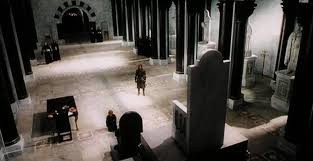On one of the first days of class,
Dr. Carter used an interesting example to communicate how media conveys a
message; he stood on the table to announce that the table itself was a medium,
and that his message changed simply because he was on the table. Marshall
McLuhan’s notion that “the medium is the message” shows us that the media or
technology we use become extensions of our bodies; so when Dr. Carter stood on
the table and his message changed, I was struck with another interesting
example of furniture as a means of communication; chairs in film.
I didn't make this leap immediately and on my own; my spare time sees a lot of video essays played on YouTube, particularly ones dedicated to film. There is one essay titled “In Praise of Chairs” which brilliantly (if unexpectedly) captures what I believe to be the essence of what McLuhan meant when he said “the medium is the message”. If you’re interested, the essay can be found here. If you’re not interested, I’ll simply summarize the key points.
The author first asserts that “In
film, a chair is not just a chair; it’s piece of production design. The type of
chair you use can say everything about the person and the world they inhabit.”
How? The author sees three different uses for chairs in film. The first is as
an extension of the world, which is the most common. Is the world clean, cool,
and futuristic? Perhaps its chairs would look something like this.
Is the world run down? Are the
characters wealthy, or scraping by? This means of communication can also serve
to illustrate power and hierarchy. Such as…
or
The second use is as an extension
of a particular character, or as a representation for the psychology of a
character. “If they’re vain, if they lack inhibition, or if they really like
joysticks…”, then these things are subtly communicated to an audience.
Or, perhaps not so subtly.
The essayist
describes the final use as being the most practical, and it is to use the chair
as an extension of the situation. This is seen when a person is forced into
acting a certain way because of the chair they’re sitting in. Chairs change the
posture and the theatrics of actors, and this is an influences the message that
audiences receive later.
So, what’s the point of this? In
analyzing the chairs present in the films and shows we watch, we’re having a
very particular set of messages communicated to us. Each chair we see was a
deliberate choice made to further the overall story, and we don’t even notice,
because they’re just chairs.




No comments:
Post a Comment